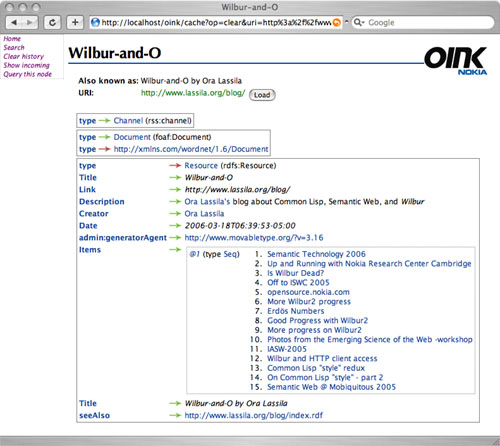Come regalo in questi giorni di festa, ecco una parte assolutamente comprensibile e inerente ai primi livelli dello stack del Semantic Web: un filmato di qc minuto da vedere…
-> Da The Semantic Web for noobs, via PlanetRDF
In pratica si cerca di spiegare il termine Semantic, in modo che sia facilmente comprensibile e divisibile dalla sintassi con la quale comunichiamo, e nello stesso tempo si rinforza l’idea che si cerca di automatizzare alcune procedure delegate oggi all’uomo inutilmente molte volte.
Visto che siamo in tema, e anche nell’ultimo post ho citato le origini del Web, ed io stesso in questi giorni mi sto studiando meglio le sue fondamenta ( _HTTP e uso corretto delle URI in particolare… _), ecco una presentazione recente ( novembre 2007 ), che ripercorre alcuni concetti del Web, sempre fondamentali:
-> Web Past and Future
Oltre a questo, aggiungo che e’ uscito il Draft per le linee guida sull’utilizzo delle URI anche in chiave semantica, frutto di una diatriba davvero complessa e con spunti notevoli negli anni…
-> Cool URIs for the Semantic Web
URIs (Uniform Resource Identifiers) more simply called “Web addresses” are at the heart of the Web and also of the Semantic Web. Cool URIs for the Semantic Web discusses two strategies for choosing URIs for the Semantic Web, gives pointers to several Web sites that use these solutions, and briefly discusses why several other alternatives are less effective.
Di queste cose esempi e utilizzi pratici arriveranno… .)
Nel frattempo, alla voce Conclusioni del Draft, sono presenti i punti focali della vicenda, che mettero’ comunque maggiormente a fuoco…
Resource names on the Semantic Web should fulfill two requirements:
- First, a description of the identified resource should be retrievable with standard Web technologies.
- Second, a naming scheme should not confuse documents and the things described by the documents.
We have described two approaches that fulfill these requirements, both based on the HTTP URI scheme and protocol.
- One is to use the 303 HTTP status code to redirect from the resource identifier to the describing document.* One is to use “hash URIs” to identify resources, exploiting the fact that hash URIs are retrieved by dropping the part after the hash and retrieving the other part.
The requirement to distinguish between resources and their descriptions increases the need for coordination between multiple URIs. Some useful techniques are:
- embedding links to RDF data in HTML documents,
- using RDF statements to describe the relationship between the URIs,
- using content negotiation to redirect to an appropriate description of a resource.
Esperimenti in corso d’opera…
Content Negotiation in primis, compresa la gestione migliore della lingua di un documento .)

